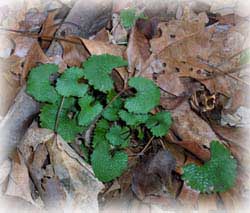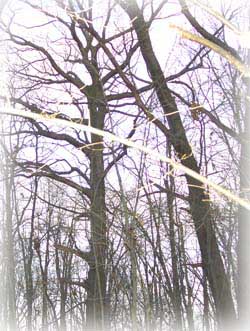Schumacher Trail and Valley Link
Cascade Valley MetroParkMetro Parks, Serving Summit County
Location
Akron, Ohio (Summit County)
Park at the Schumacher Valley parking lot of Cascade Valley MetroPark on Cuyahoga Street. This is just south of Portage Trail.
Summary
Length: 1.2 miles
Duration: 1 1/2 hours, more if you take the Valley Link to the Towpath Trail.
Surface: natural, uneven, can be muddy or icy at times.
Type: hiking loop trail.
Difficulty: moderate
Accessibility: No. (uneven surfaces, narrow trail, some steep areas)

Basal rosettes of the non-native invasive plant garlic mustard along the trail.
Description
This hiking trail traverses three distinctly different forest habitats. After you pass under the powerlines at the beginning of the trail, the forest is young and exhibits edge effects due to nearby disturbances such as rsidential and industrial development which has allowed more light and wind into the forest. In these areas, earlier successional plants which love light tend to predominate. The vegetation on the ground is also thicker along edges. As you continue on your hike, you will notice that the trees get larger, and that the forest becomes dominated by red and black oaks (Quercus spp.). Many of the oaks in this area are in the range of roughly 14 to 30 inchs diameter at breast height. Here, the forest is less impacted by the nearby development. The non-native invasive herb, garlic mustard (Alliaria petiolata), pictured here, is much less prevalent than in the high light environment of the edge. Native wildflowers such as Spring beauty (Claytonia virginiana), Rue anemone (Anemonella thalictroides), bloodroot (Sanguinaria canadensis)and yellow fawn lillies (Erythronium americana) paint the forest floor in the springtime.
As you pass from this forest into a younger successional area, the trail heads steeply down hill. Here you will note the smooth, light gray to greenish-yellowish bark of aspens (Populus spp), as well as the dark furrowed bark of sassafras (Sassafras albidum). Both of these are pioneer species.

An open grown Oak along the Schumacher Trail.
Pioneer species need plenty of light to grow well, and their presence in large nearly pur stands generaly indicates that an area was an open field at some time in the past. This area was very likely a farm pasture a generation ago. Why a pasture and not a cornfield?
First, you will notice that there are many rocks sticking out of the soil as you hike through these woods. If the area were ever row-cropped, these stones would have been removed to prevent damage to plows and other equipement. Second, there are a number of "open grown" trees in the forest. These trees, like that pictured at the right, have broad crowns and the lowest branches emerge much lower on the tree than those of forest grown trees which are forced to grow rapidly upwards to compete for light. These trees are often allowed to grow in pastures as shade for cattle.
Third, the wildflowers and tree seedlings appear to grow well and in prolific numbers. Often former row-cropped areas are depleted of their nutrients and the soils damaged by over-use. In those areas, even one hundred years later wildflower and tree seedlings can have a difficult time growing.
The third forest type you will notice while hiking this nature trail is the beech (Fagus grandifolia) and maples (Acer spp) which grow in and along the steep, deep ravines of this serene park. As you hike along the trail, notice the gray bark of the beeches and see if they are not almost exclusively found in the ravines, while the flatter drier areas are dominated by either oaks or early successional species. Why do you think this is?
Beyond the diversity of forest habitats, many niche habitats exist within this forest. One great component of this forest is the large number of standing dead trees as well as the amount of downed wood on the forest floor. These decaying trees are good habitat for invertibrates and serve as valuable shelter for birds and small mammals as well. Marks on these trees are a testament to the presence of many woodpeckers in the area.
Walk this trail early on any sunday morning before traffic has broken the silence and you will hear at least four species of woodpeckers hammering in the distance. The woods abounds with songbirds as well. Bring a bird guide, a wildflower guide and a tree guide and you could spend an entire day here.
At the furthest point on the Schumacher trail, the Valley connector trail splits off and descends into the floodplain of the Cuyahoga River, across the river and to the Ohio and Erie Canal Towpath Trail.
Nearby Trails
Highbridge Trail, Cascade Valley and Gorge (Metroparks, Serving Summit County)
Oxbow Trail, Cascade Valley MetroPark (Metroparks, Serving Summit County)
Chuckery Trail, Cascade Valley MetroPark (Metroparks, Serving Summit County)
Gorge Trail, Gorge MetroPark (Metroparks, Serving Summit County)
Glens Trail, Gorge (Metroparks, Serving Summit County)
